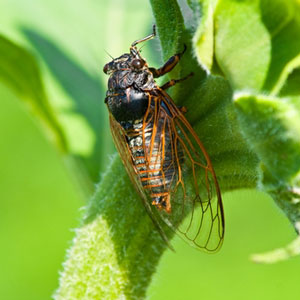Northeast Cicada Hatch Will Affect Some of Us
By Chris Williams on April 19, 2013.

Question
I keep reading about this upcoming cicada hatch that’s about to hit the Northeast. Are we going to see the cicadas here?
Answer
Of course that depends on where you are located. If you’re in our service area, Massachusetts and New Hampshire, afraid not. We’re just a little too far north. We get sort of cheated here when it comes to periodical cicada hatches, at least that’s one entomologist’s view. We don’t get any of the really spectacular hatches that are seen in the Midwest and farther south.
This periodical cicada hatch is going to be seen in parts of east coast states from the Carolinas north to New York and Connecticut. According to the website, Massachusetts Cicadas, the most northern range of this cicada hatch will be the eastern portion of upstate New York. The distribution stops at the border of Massachusetts and starts again in Connecticut. No one knows why the cicadas aren’t found in Massachusetts. Maybe they’ve just never been reported.
This hatch, which will be appearing in mid-May, is Brood II of the 17-year periodical cicadas. This group of cicadas last made their appearance in 1996 and won’t be seen again until 2030! That’s what makes a cicada emergence such a special event; you don’t see many in your lifetime. There are 12 different broods of 17-year cicadas, and three 13-year cicada broods. Most years at least one of the broods emerges somewhere in the U.S., east of the Mississippi.
Periodical cicada nymphs spend 17 (or 13) years underground feeding on plant roots. How they know that it’s their year to emerge is a biological mystery. They burrow to the surface, leaving pencil-sized holes), climb onto tree trunks and other surfaces, split their nymphal skins and emerge as winged, adult cicadas. When a periodical cicada brood emerges, it does so over a few days in a noisy, impressive way. Some of you in Massachusetts may have witnessed emergence of Brood XIV in 2008. Adult cicadas buzz in the treetops for several weeks as they mate and lay eggs in the tips of branches. The nymphs hatch and drop from the trees to burrow into the ground for the next 17 years.
Just because we won’t be hosting Brood II, doesn’t mean that we don’t have cicadas. Annual cicadas emerge here every summer. These larger, green and black cicadas have a similar, but much shorter, life cycle. We often call them “dog day cicadas” because they emerge in mid to late summer. We associate their buzzing noise with hot, humid weather.
If you’re in Massachusetts and are feeling left out, console yourself with the fact that Brood XIV will be back in 2025. If you do see black cicadas with red eyes, you can report your find at www.masscic.org where experts are tracking the Brood II hatch in the Northeast.